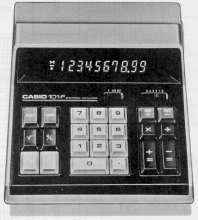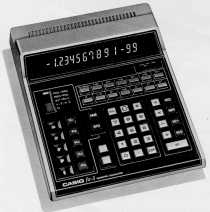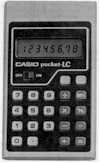by
Ray Mackay
| About
the author The author was engaged as service manager for Peacock Bros. of Melbourne for the period 1954 through 1975. During that period he worked on Comptometers (by Felt & Tarrant) MADAS (by H.W.Egli), and Walther (by Carl Walther's Company). In the early seventies the advent of digital electronics started a kind of technological revolution and mechanical calculating machines started to be usurped by the 'new kid on the block' technology. As Japanese companies such as Busicom, Sharp, Toshiba and others juggled for positions in a rapidly evolving market, a company dedicated to the manufacturing of computer equipment slipped gently into position. The company Casio Computer Company started manufacturing calculators and later watches. Some products were serious others were 'novelty' items. This report consists of memories by the author Ray Mackay. Many of the memories are supported by documentation. Other memories, where documentation does not exist, have been left out. About Casio Information related to Casio's beginnings is scant and hard to come by. The author's first knowledge the company even existed was in the very early seventies when he first sighted the early products from the company. These products being sold through Peacock & Associates. During this period a Mr. Kawamura was the Australian Agent and the product was marketed through Peacock Bros. as a parallel line to other products. Endeavours are being made to provide a firm foothold concerning Casio's beginnings and, if and when such details become available, they will be inserted into this report. The calculators The format, at least in this draft, will take on a sequence related to dates. As various models became available an illustration, where available, will be given plus some technical aspects of each model. Actual release dates are not known, however the schematics indicate model numbers and dates which should provide some guidance. Where prices are given they will be indicated in the currency of the source of the price (i.e. AUD will indicate Australian Dollars). The form will be a little boring as there is no attractive way to list the information. It could be done either with illustrations or as a list. It should be remembered that some models were marketed through companies such as Tandy, Radio Shack and Remington Rand and possibly others. If Trade Marks exist for such products acknowledgement is given to the trade mark holders. The document is produced for the information of collectors and educators. It is not to be sold privately for profit however, it may be copied and distributed freely for the purpose and reason it is written. |
||||||||||||
| The earliest
model known by the author was the Remington SSR-8 sold
under the Casio Name FX-1- and FX-11. Circa May 1974 the
machine was listed as follows: Drawing Number A8B-1 Display fluoro Glass Encapsulated driven by an IC driver MicroPD 175C CPU Micro-Chip MicroPD179C (which would indicate NEC) Power Battery Mains Prices not known NO ILLUSTRATIONS Early models were the
Mini-root-M, Mini Memory, Mini-root & 801MR. These
were sold as Remington Models 821GT, 823GT, 819 &
825GT circa July 1974 (the author does not know if the
designs were Remington or Casio designs). Technical
aspects are as follows : In February of 1975 the inventive nature of Casio came to the fore front and machines began being released in a continuous stream. First the Personal-8 using a MicroPD973C CPU and fluoro display. This was followed by a Personal-8M in March. This machine seemed to use a Toshiba T3315 CPU and an E8120.
|
||||||||||||
One assumes larger machines were required for large fingers and for the desktop but were still required to be portable and in July 1975 the Casio 102-MR came out. Using a HD3692 and LD8126 fluoro display it could be popped into a suitcase and presented large keys for the operator. |
||||||||||||
 Also around the same period. The
Casio Model 101F (AX 15A-a) had many of the features of
the 101 and 102MR's but had a new key placement design
for touch usage rather than the look and press keyboards
of the earlier machines. It started to come with the type
of keyboard we had become familiar with over the years.
The 101-F was followed (also in July) with a 121-F which
looked identical to the 101-F but had an extra 2 digits
in the display. The ON/OFF switch also came up on to the
keyboard. Other than these differences the illustration
on the right will suit as a guide. Also around the same period. The
Casio Model 101F (AX 15A-a) had many of the features of
the 101 and 102MR's but had a new key placement design
for touch usage rather than the look and press keyboards
of the earlier machines. It started to come with the type
of keyboard we had become familiar with over the years.
The 101-F was followed (also in July) with a 121-F which
looked identical to the 101-F but had an extra 2 digits
in the display. The ON/OFF switch also came up on to the
keyboard. Other than these differences the illustration
on the right will suit as a guide. |
||||||||||||
|
||||||||||||
|
||||||||||||
 In August, the same month, a
desktop scientific calculator the FX-3 was released,
having a number of trigonometric functions plus several
memories. This machine appeared, at the time, to be
attacking a specific market. This target escaped me as,
although it was a desktop machine, it appeared to have
severe limitations for 'real' scientific use. The chipset
appeared to be a four chip Hitachi chip set judging by
the HD prefixes. One appeared to be the CPU (HD3555) a
second a multiplexer ? chip HN25301 and the third
(HD36610) a display driver. The fourth with a We (write
enable?) pin could also be a memory chip. November saw
the release of a Memory-8R which looked like the CM-607
(seen earlier) but had a square root key. The format
otherwise remained the same. The CPU was a HD3691 and the
display fluoro. In August, the same month, a
desktop scientific calculator the FX-3 was released,
having a number of trigonometric functions plus several
memories. This machine appeared, at the time, to be
attacking a specific market. This target escaped me as,
although it was a desktop machine, it appeared to have
severe limitations for 'real' scientific use. The chipset
appeared to be a four chip Hitachi chip set judging by
the HD prefixes. One appeared to be the CPU (HD3555) a
second a multiplexer ? chip HN25301 and the third
(HD36610) a display driver. The fourth with a We (write
enable?) pin could also be a memory chip. November saw
the release of a Memory-8R which looked like the CM-607
(seen earlier) but had a square root key. The format
otherwise remained the same. The CPU was a HD3691 and the
display fluoro. |
||||||||||||
 November
saw the release of the first LCD display from Casio, the
Pocket-LC it had the usual four function plus Square root
and Percentage plus a memory recall key. November
saw the release of the first LCD display from Casio, the
Pocket-LC it had the usual four function plus Square root
and Percentage plus a memory recall key. Naturally, as one would expect, it was far slimmer than the 'fluoro' display calculators. The Chip was a T333 and the LD0503 display was mounted in a cradle for easy placement and replacement. Schematics are available for the display timing. |
||||||||||||
There must however, be reasons behind such timing and one supposes that the time delay between design of IC's, the placement of orders and the drawing to manufacturer delay causes such anomalies. |
||||||||||||
WE
MOVE ON TO 1976 ANOTHER BIG YEAR FOR CASIO CASIO PERSONAL 1 (H-802), AL-8 AND AL-10 (FRACTION CALCS), POCKET LC (CL-811B) AND POCKET LC II
|
||||||||||||
At this stage it became a non-viable proposition for the author to store spare parts and carry out repairs on such small mark-up items. The one Biolator et al were MicroPD572C - MicroPD 577C (HD 36145) - MicroPD573C and the Old T3333. Peacock Bros. ceased to replace individual components and, because of the ultra reliability of the units, a change over policy during the warranty period was adopted. The author's technical interest started to waine and his intellectual pursuits started to take new directions. North American Rockwell was designing new products and these took up time and the interest of the author. Due to obligations the author continued support of Casio but became more orientated towards the sales; whilst still maintaining Comptometers, MADAS and Walther mechanical machines. Plus the new electronic Walther and Busicom machines. As an aside the collection of Casios continued to grow. New models were released in a constant stream. The author collected information until 1978 and then the process became repetitive. There is not much to see or work on with IC's and without intellectual stimulation interest is hard to maintain. The continuation will list machines and illustrate the models that followed as far as 1978. These models from left to right being... FX-19
Scientific Calculator (AX-38A-A) , P811 Pocket Mini
(AX-44A-A), Micro-Mini (AX-49A), FX-102 Scientific
Calculator,
|
||||||||||||
I will continue in this format so that those interested may have a guide to different models. Those who download the site can enlarge or clear the GIF images to suit. The Internet is convenient and if some 'enthusiasts' require schematic or chip details they only need to ask. Commercial inquiries should be addressed to www.casio.co.jp or www.casio-usa.com as these notes are for hobbies only and not intended for commercial use. These in order from left to right are as follows... Personal M1
(AX-72A-A), R-220 (AX-25A-A, 805MR (AX-62A-A),
|
||||||||||||
At this stage we are
coming to the end of this collection. If you've got this
far I award you the medal of perseverence for answering a
call beyond duty. It has been a time consuming exercise
and one must admit, rather a dull exercise. In order of appearance left to right... FX-2000 (AX-82),
FX-110 (AX-78A-A), AL-10S (AX-76A-A),
Crossing the boundary 1977 to 1978. In order of appearance left to right... CQ-81 (GX-63),
AQ-1000 (GX-26), MQ-5 (GX-66),
|
||||||||||||
I also have line drawings indicating keyboard configurations and machine body shapes of early Casios between 1969 and 1974. Some of these may be of historic use, however the technological information is no longer of value unless one wishes to restore a particular model. Cataloging this lot for the Internet is impracticable. Machines from Casio's latest range are illustrated on our Web Site www.casio.calculators.com.au and using the Hyperlink to Pegasus and other sites additional information is available. For those members of James Redin's Collectors Database and Guy Ball's International Association of Calculator Collectors that request the enclosed information I trust it suits their need. There is a full days work in such an activity and unless it helps some one, there is little sense in pursuing the project, as a Web Page, any further. In the end the mind starts to boggle as one tries to remember where one is at. Casio's innovative style seems to assure steady growth. New machines are released in a constant stream as the latest Casio catalogues will indicate. Further inquiries may be placed with highlander@i.net.au. Having said that we can put the project to bed. Regards Ray Mackay |
||||||||||||
| Copyright
© January 1998 Ray Mackay All rights reserved ® 1998
French translation by Anna Chekovsky |
||||||||||||
Updated January 04, 2015